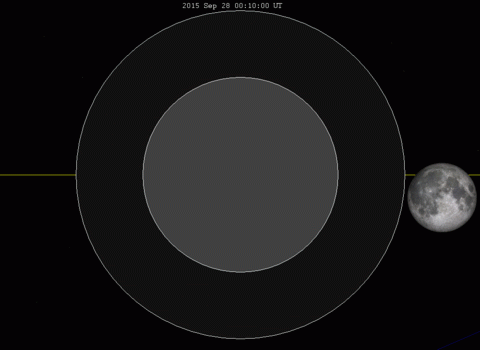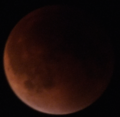September 2015 lunar eclipse
| Total eclipse | |||||||||||||||||
 Totality as viewed from Murrieta, California, 2:52 UTC | |||||||||||||||||
| Date | September 28, 2015 | ||||||||||||||||
|---|---|---|---|---|---|---|---|---|---|---|---|---|---|---|---|---|---|
| Gamma | −0.3296 | ||||||||||||||||
| Magnitude | 1.2774 | ||||||||||||||||
| Saros cycle | 137 (28 of 81) | ||||||||||||||||
| Totality | 71 minutes, 55 seconds | ||||||||||||||||
| Partiality | 199 minutes, 52 seconds | ||||||||||||||||
| Penumbral | 310 minutes, 41 seconds | ||||||||||||||||
| |||||||||||||||||
A total lunar eclipse occurred at the Moon’s descending node of orbit on Monday, September 28, 2015,[1] with an umbral magnitude of 1.2774. A lunar eclipse occurs when the Moon moves into the Earth's shadow, causing the Moon to be darkened. A total lunar eclipse occurs when the Moon's near side entirely passes into the Earth's umbral shadow. Unlike a solar eclipse, which can only be viewed from a relatively small area of the world, a lunar eclipse may be viewed from anywhere on the night side of Earth. A total lunar eclipse can last up to nearly two hours, while a total solar eclipse lasts only a few minutes at any given place, because the Moon's shadow is smaller. Occurring only about 5 hours after perigee (on September 27, 2015, at 21:45 UTC), the Moon's apparent diameter was larger.[2]
This lunar eclipse is the third of a tetrad, with four total lunar eclipses in series, the others being on April 15, 2014; October 8, 2014; and April 4, 2015.
The Moon appeared larger than normal, because the Moon was just 1 hour past its closest approach to Earth in 2015 at mid-eclipse, sometimes called a supermoon. The Moon's apparent diameter was larger than 34' viewed straight overhead, just off the coast of northeast Brazil.[3][4]
The total lunar eclipse was darker than expected, possibly due to ash left behind from eruptions of the Calbuco volcano in April 2015.[5]
Background
[edit]A lunar eclipse occurs when the Moon passes within Earth's umbra (shadow). As the eclipse begins, Earth's shadow first darkens the Moon slightly. Then, the shadow begins to "cover" part of the Moon, turning it a dark red-brown color (typically – the color can vary based on atmospheric conditions). The Moon appears to be reddish because of Rayleigh scattering (the same effect that causes sunsets to appear reddish) and the refraction of that light by Earth's atmosphere into its umbra.[6]
The following simulation shows the approximate appearance of the Moon passing through Earth's shadow. The Moon's brightness is exaggerated within the umbral shadow. The northern portion of the Moon was closest to the center of the shadow, making it darkest, and most red in appearance.
Supermoon
[edit]This eclipsed Moon appeared 12.9% larger in diameter than the April 2015 lunar eclipse, measured as 29.66' and 33.47' in diameter from Earth's center, as compared in these simulated images.
A supermoon is the coincidence of a full moon or a new moon with the closest approach the Moon makes to the Earth on its elliptical orbit, resulting in the largest apparent size of the lunar disk as seen from Earth. This was the last supermoon lunar eclipse until January 31, 2018.

Visibility
[edit]The eclipse was completely visible over eastern North America, South America, west Africa, and western Europe, seen rising over western North America and the eastern Pacific Ocean and setting over east Africa, eastern Europe, and west and central Asia.[7]

|
 Hourly motion shown right to left |
 Simulated appearance of Earth and atmospheric ring of sunlight |
 The Moon's hourly motion across the Earth's shadow in the constellation of Pisces. |
 Visibility map | |||
Timing
[edit]| Time Zone adjustments from UTC |
-7h | -6h | -5h | -4h | -3h | -2h | -1h | 0h | +1h | +2h | +3h | |
|---|---|---|---|---|---|---|---|---|---|---|---|---|
| PDT MST |
MDT | CDT PET |
EDT BOT |
ADT AMST ART |
GMT WET |
WEST CET BST |
CEST EET MSK−1 |
EEST FET MSK | ||||
| Event | Evening 27 September | Morning 28 September | ||||||||||
| P1 | Penumbral begins* | N/A† | N/A† | 7:12 pm | 8:12 pm | 9:12 pm | 10:12 pm | 11:12 pm | 12:12 am | 1:12 am | 2:12 am | 3:12 am |
| U1 | Partial begins | N/A† | 7:07 pm | 8:07 pm | 9:07 pm | 10:07 pm | 11:07 pm | 12:07 am | 1:07 am | 2:07 am | 3:07 am | 4:07 am |
| U2 | Total begins | 7:11 pm | 8:11 pm | 9:11 pm | 10:11 pm | 11:11 pm | 12:11 am | 1:11 am | 2:11 am | 3:11 am | 4:11 am | 5:11 am |
| Mid-eclipse | 7:47 pm | 8:47 pm | 9:47 pm | 10:47 pm | 11:47 pm | 12:47 am | 1:47 am | 2:47 am | 3:47 am | 4:47 am | 5:47 am | |
| U3 | Total ends | 8:23 pm | 9:23 pm | 10:23 pm | 11:23 pm | 12:23 am | 1:23 am | 2:23 am | 3:23 am | 4:23 am | 5:23 am | 6:23 am |
| U4 | Partial ends | 9:27 pm | 10:27 pm | 11:27 pm | 12:27 am | 1:27 am | 2:27 am | 3:27 am | 4:27 am | 5:27 am | 6:27 am | Set |
| P4 | Penumbral ends | 10:22 pm | 11:22 pm | 12:22 am | 1:22 am | 2:22 am | 3:22 am | 4:22 am | 5:22 am | 6:22 am | Set | Set |
† The Moon was not visible during this part of the eclipse in this time zone.
* The penumbral phase of the eclipse changes the appearance of the Moon only slightly and is generally not noticeable.[8]

The timing of total lunar eclipses are determined by its contacts:[9]
|
Gallery
[edit]-
The stages of the Lunar eclipse from Staffordshire, UK
-
Time-lapse images from Oslo, Norway
-
Time-lapse images from Bregenz, Austria
-
Warsaw, Poland, 2:01 - 2:16 UTC
-
Denver, Colorado, 2:15 UTC
-
Fray Bentos, Uruguay 2:28 UTC
-
Tampa, Florida, 2:30 UTC
-
New York City, New York, 2:36 UTC
-
Wrocław, Poland, 2:36 UTC
-
Zürich, Switzerland, 2:36 UTC
-
Coralville, Iowa, 2:52 UTC
-
Munich, Germany, 2:55 UTC
-
Sitia, Greece, 3:01 UTC
-
Berlin, Germany, 3:05 UTC
-
Mill Valley, California, 3:07 UTC
-
Munich, Germany, 3:23 UTC
-
Boston, Massachusetts, 3:24 UTC
-
Germany, 3:37 UTC
-
Cosne-Cours-sur-Loire, France, 4:02 UTC
-
California, 4:07 UTC
Eclipse details
[edit]Shown below is a table displaying details about this particular solar eclipse. It describes various parameters pertaining to this eclipse.[10]
| Parameter | Value |
|---|---|
| Penumbral Magnitude | 2.23071 |
| Umbral Magnitude | 1.27744 |
| Gamma | −0.32960 |
| Sun Right Ascension | 12h17m08.9s |
| Sun Declination | -01°51'20.9" |
| Sun Semi-Diameter | 15'57.6" |
| Sun Equatorial Horizontal Parallax | 08.8" |
| Moon Right Ascension | 00h17m33.6s |
| Moon Declination | +01°32'03.6" |
| Moon Semi-Diameter | 16'44.5" |
| Moon Equatorial Horizontal Parallax | 1°01'26.6" |
| ΔT | 67.8 s |
Eclipse season
[edit]This eclipse is part of an eclipse season, a period, roughly every six months, when eclipses occur. Only two (or occasionally three) eclipse seasons occur each year, and each season lasts about 35 days and repeats just short of six months (173 days) later; thus two full eclipse seasons always occur each year. Either two or three eclipses happen each eclipse season. In the sequence below, each eclipse is separated by a fortnight.
| September 13 Ascending node (new moon) |
September 28 Descending node (full moon) |
|---|---|
 |

|
| Partial solar eclipse Solar Saros 125 |
Total lunar eclipse Lunar Saros 137 |
Related eclipses
[edit]Eclipses in 2015
[edit]- A total solar eclipse on March 20.
- A total lunar eclipse on April 4.
- A partial solar eclipse on September 13.
- A total lunar eclipse on September 28.
Metonic
[edit]- Preceded by: Lunar eclipse of December 10, 2011
- Followed by: Lunar eclipse of July 16, 2019
Tzolkinex
[edit]- Preceded by: Lunar eclipse of August 16, 2008
- Followed by: Lunar eclipse of November 8, 2022
Half-Saros
[edit]- Preceded by: Solar eclipse of September 22, 2006
- Followed by: Solar eclipse of October 2, 2024
Tritos
[edit]- Preceded by: Lunar eclipse of October 28, 2004
- Followed by: Lunar eclipse of August 28, 2026
Lunar Saros 137
[edit]- Preceded by: Lunar eclipse of September 16, 1997
- Followed by: Lunar eclipse of October 8, 2033
Inex
[edit]- Preceded by: Lunar eclipse of October 17, 1986
- Followed by: Lunar eclipse of September 7, 2044
Triad
[edit]- Preceded by: Lunar eclipse of November 27, 1928
- Followed by: Lunar eclipse of July 30, 2102
Lunar eclipses of 2013–2016
[edit]The lunar year series repeats after 12 lunations, or 354 days (shifting back about 10 days in sequential years). Because of the date shift, Earth's shadow will be about 11 degrees west in sequential events.
| Lunar eclipse series sets from 2013–2016 | ||||||||
|---|---|---|---|---|---|---|---|---|
| Ascending node | Descending node | |||||||
| Saros | Viewing date |
Type | Gamma | Saros | Viewing date |
Type | Gamma | |
112
|
2013 Apr 25
|
Partial
|
−1.0121 | 117
|
2013 Oct 18
|
Penumbral
|
1.1508 | |
122
|
2014 Apr 15
|
Total
|
−0.3017 | 127
|
2014 Oct 08
|
Total
|
0.3827 | |
132
|
2015 Apr 04
|
Total
|
0.4460 | 137
|
2015 Sep 28
|
Total
|
−0.3296 | |
| 142 | 2016 Mar 23
|
Penumbral
|
1.1592 | 147
|
2016 Sep 16
|
Penumbral
|
−1.0549 | |
| Last set | 2013 May 25 | Last set | 2012 Nov 28 | |||||
| Next set | 2017 Feb 11 | Next set | 2016 Aug 18 | |||||
Saros 137
[edit]It is part of Saros series 137.
Half-Saros cycle
[edit]A lunar eclipse will be preceded and followed by solar eclipses by 9 years and 5.5 days (a half saros).[11] This lunar eclipse is related to two annular solar eclipses of solar saros 144.
| September 22, 2006 | October 2, 2024 |
|---|---|

|

|
See also
[edit]References
[edit]- ^ "September 27–28, 2015 Total Lunar Eclipse (Blood Moon)". timeanddate. Retrieved 16 November 2024.
- ^ "Moon Distances for London, United Kingdom, England". timeanddate. Retrieved 16 November 2024.
- ^ Sky and Telescope
- ^ Here’s the Scoop on Sunday’s Supermoon Eclipse, Bob King
- ^ "Why Was September's Lunar Eclipse So Dark? - Universe Today". Universe Today. 5 October 2015. Retrieved 8 August 2017.
- ^ Fred Espenak & Jean Meeus. "Visual Appearance of Lunar Eclipses". NASA. Retrieved 13 April 2014.
- ^ "Total Lunar Eclipse of 2015 Sep 28" (PDF). NASA. Retrieved 16 November 2024.
- ^ Espenak, Fred. "Lunar Eclipses for Beginners". MrEclipse. Retrieved 7 April 2014.
- ^ Clarke, Kevin. "On the nature of eclipses". Inconstant Moon. Cyclopedia Selenica. Retrieved 19 December 2010.
- ^ "Total Lunar Eclipse of 2015 Sep 28". EclipseWise.com. Retrieved 16 November 2024.
- ^ Mathematical Astronomy Morsels, Jean Meeus, p.110, Chapter 18, The half-saros
External links
[edit]- 2015 Sep 28 chart: Eclipse Predictions by Fred Espenak, NASA/GSFC
- Hermit eclipse: 2015-09-28
























